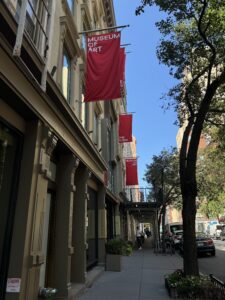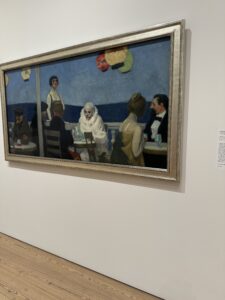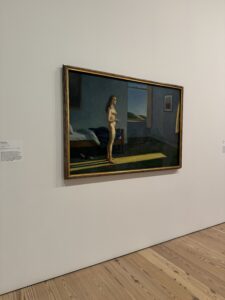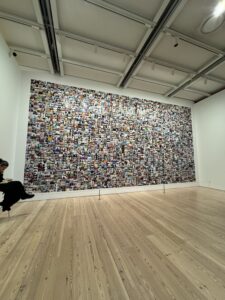My initial impression of museums has always been negative so this wasn’t much different. I thought this would be just as boring as the other museums I have visited. Even though my visit didn’t start as I planned, I was definitely pleasantly surprised. I actually planned to visit the Rubin as I heard good things about it and it was the most convenient to get to. Unfortunately, that visit ended up being very disappointing. When I arrived I was greeted with locked doors, I had no idea the museum was closed on Mondays. I did however take a picture of the outside so that was nice;) I ended up taking a bit of a detour to the Whitney, which actually took me by surprise how much I enjoyed it. Despite it being more modern art it had some great pieces.

The first art piece that captured my attention was by Blythe Bohnen.

This was a unique piece that focused on the use of motion in order to capture a self portrait. It is strange because typically in a self portrait you are able to view every detail of the subject however this art piece is very up to interpretation. It portrays a moment in time that should show facial features of the subject but rather gives the viewers an unsettling and obstructed view of the portrait. There is no tell of who the person is but it feels like you can create a story based on the mere interpretation of their eyes. This piece pushes the viewer to imagine their own version of the self portrait as what is show is just a fraction of what it could be. Art is subjective, and just like John Berger believed, the camera can only capture so much in a moment of time. It made me understand that personal identity can be beyond a strict and motionless interpretation and rather a fluid and ever-evolving state. On the surface, I see a simple portrait, however upon further analysis I feel the complexity in the personality of the subject. The repetitive motion suggested to me the idea of cycles in life. Furthermore, the various phases of individuals lives that can’t be seen in a simple painting but this piece helped me see the complexity of the different phases of people’s lives which they continuously revisit and reinterpret with their identity. Overall, I was really drawn to this painting, however, it was odd since going in I had such a pessimistic view and the first painting already struck me.
The next art piece was by Edward Hopper.
This painting was unique in its color. It was very bright and the strange addition of a clown drew me in. I was fascinated to learn what the original intent or the painting was because I had already made an interpretation on my own. The original purpose was an account of the artists experience in a Parisian art school where they combined numerous visits to different cafes and added their interpretation of the people around. To me, it touches on the divide in society today. Furthermore, the idea that there is always an outcast that sticks out like a sore thumb which is illustrated by the clown, while the people are clear critics for no apparent reason. It also touches on the idea of self awareness because how you see yourself may not always be the truth. The clown can portray that you are your worst enemy, and that not everyone is out to get you. It may always seem that you are the center of attention hence the portrayal of the clown in the center but it is foolish to think so. The piece made me feel a sense of coldness and isolation due to the high contrast of the colors. The calmer colors invoked a series of melancholy thoughts and contemplation that pushed a theme of emotional isolation which the subjects faces revealed. It seemed like even in a social setting everyone was so disconnected, much like the world today with advent of technology. Overall, there was nothing that I didn’t like in this piece, it was very complex and promoted deep thought.
The next piece was also by Edward Hopper.
Initially, when I saw this painting, I walked right by it, however, upon second glance, I realize it was not much different than the paintings that we analyzed from John Berger’s book. I went back to see how the artist described this painting since much like the painting by Van Gogh that initially didn’t mean much without the words attached, this painting didn’t mean much without the words attached. After reading the purpose of the art piece it changed my perspective on it overall. The model in the painting was the artist’s wife who was 78 at the time of the creation of the work, however instead of painting, the realistic details, he created his everlasting idea of her from his memory. This open ended scene allows viewers to create a narrative of their own. This made me think of the quote from John Berger’s book about the difference of nakedness and nude. As the quote describes, you can be naked at all times, but it is only considered nude when you were viewed by others, I believe the artist wanted the viewers to understand the painting in that perspective. The use of light on the model pushes a theme of detachment from her environment which I interpreted as her careless persona. Yet I think this application of light does not idealize the woman’s isolation but rather exposes it. Her body language makes me think of a state of quiet contemplation and solitude. I feel like her nakedness goes beyond physical state but is also emotional and psychological all at once. To me, it felt like a raw depiction of a woman’s state and not one that is idealized.
The last piece of art was by Carmen Winant.
Although, I liked the message of the art piece it seemed too elementary to be considered art. Yes, the progression of the photographs was moving in the sense that it showed the evolution of the female reproductive rights but do I consider this art, no. Overall, this was not one of my favorite art pieces, the meaning was great but the portrayal not so much. There was no real deeper meaning that I could continue to analyze and that is something that I appreciate in most art pieces.
To conclude, my visit to The Whitney changed by view on most art museums as there can be art for everyone. Even though, museums are still not my favorite activity it is fun to analyze the deeper meaning of art pieces. I would visit the Whitney again with friends, I had a great time and all the exhibits were so unique.


